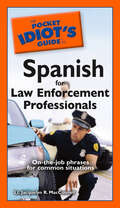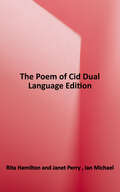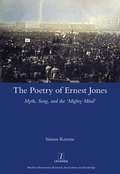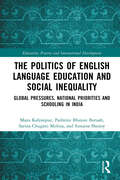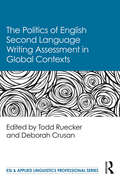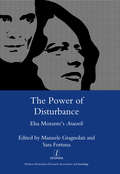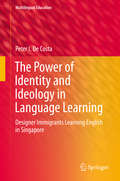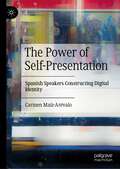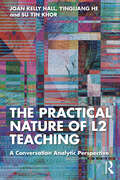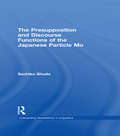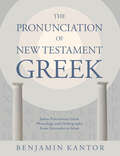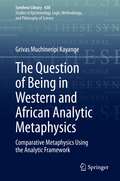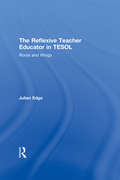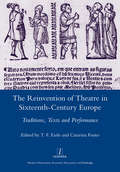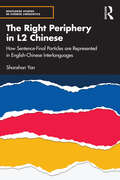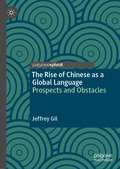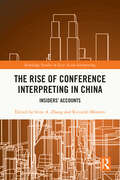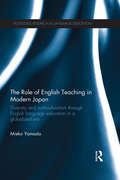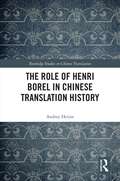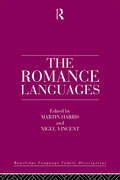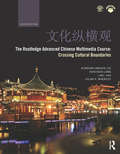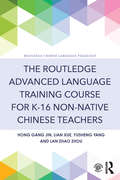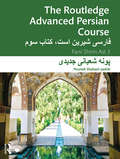- Table View
- List View
The Pocket Idiot's Guide to Spanish for Law Enforcement Professionals
by Lt. Jacquelyn R. MacConnellCommunicate with ease with the Spanish-speaking public!Learning Spanish is vital to performing many public services, include police work and other law-enforcement professions. Police, patrollers, detectives, and corrections, parole, court, and security officers who interact with Spanish-speaking people need this specialized, easy-to-use guide to help them communicate and sometimes translate quickly and effectively—anywhere.• From expert authors with experience in Spanish language instruction for law enforcement officials.• Essential phrases—including Miranda rights—and vocabulary for patrol, investigations, emergency situations, narcotics, corrections, and more.• Easy-to-use phonetic translations.• Useful information on Latino culture and street Spanish.
The Poem of the Cid
by Janet Perry Rita HamiltonOne of the finest epic poems, and the only one to have survived from medieval Spain, The Poem of the Cid recounts the adventures of the warlord and nobleman Rodrigo Diaz de Vivar - 'Mio Cid'. A forceful combination of heroic fiction and historical fact, the tale seethes with the restless, adventurous spirit of Castille, telling of the Cid's unjust banishment from the court of King Alfonso, his victorious campaigns in Valencia, and the crowning of his daughters as queens of Aragon and Navarre - the high point of his career as a warmonger. An epic that sings of universal human values, this is one of the greatest of all works of Spanish literature.
The Poetry of Ernest Jones Myth, Song, and the ‘Mighty Mind’: Myth, Song, And The 'mighty Mind (Legenda Ser.)
by Simon RennieAs the last leader of the Chartist movement, Ernest Charles Jones (1819-69) is a significant historical figure, but he is just as well-known for his political verse. His prison-composed epic The New World lays claim to being the first poetic exploration of Marxist historical materialism, and his caustic short lyric ‘The Song of the Low’ appears in most modern anthologies of Victorian poetry. Despite the prominence of Jones’s verse in Labour history circles, and several major inclusions in critical discussions of working-class Victorian literature, this volume represents the first full-length study of his poetry. Through close analysis and careful contextualization, this work traces Jones’s poetic development from his early German and British Romantic influences through his radicalization, imprisonment, and years of leadership. The poetry of this complex and controversial figure is here fully mapped for the first time.
The Politics of English Language Education and Social Inequality: Global Pressures, National Priorities and Schooling in India (Education, Poverty and International Development)
by Maya Kalyanpur Padmini Bhuyan Boruah Sarina Chugani Molina Sunaina ShenoyBased on policy analysis and empirical data, this book examines the problematic consequences of colonial legacies of language policies and English language education in the multilingual contexts of the Global South. Using a postcolonial lens, the volume explores the raciolinguistics of language hierarchies that results in students from low-income backgrounds losing their mother tongues without acquiring academic fluency in English. Using findings from five major research projects, the book analyzes the specific context of India, where ambiguous language policies have led to uneasy tensions between the colonial language of English, national and state languages, and students’ linguistic diversity is mistaken for cognitive deficits when English is the medium of instruction in schools. The authors situate their own professional and personal experiences in their efforts at dismantling postcolonial structures through reflective practice as teacher educators, and present solutions of decolonial resistance to linguistic hierarchies that include critical pedagogical alternatives to bilingual education and opportunities for increased teacher agency. Ultimately, this timely volume will appeal to researchers, scholars, academics, and students in the fields of international and comparative education, English and literacy studies, and language arts more broadly. Those interested in English language learning in low-income countries specifically will also find this book to be of benefit to their research.
The Politics of English Second Language Writing Assessment in Global Contexts (ESL & Applied Linguistics Professional Series)
by Todd Ruecker Deborah CrusanReflecting the internationalization of the field of second language writing, this book focuses on political aspects and pedagogical issues of writing instruction and testing in a global context. High-stakes assessment impacts the lives of second language (L2) writers and their teachers around the world, be it the College English Test in China, Common Core-aligned assessments in the U.S., English proficiency tests in Poland, or the material conditions (such as access to technology, training, and other resources) affecting a classroom. With contributions from authors working in ten different countries in a variety of institutional contexts, the chapters examine the uses and abuses of various writing-related assessments, and the policies that determine their form and use. Representing a diverse range of contexts, methods, and disciplines, the authors jointly call for more equitable testing systems that consider the socioeconomic, psychometric, affective, institutional, and needs of all students who strive to gain access to education and employment opportunities related to English language proficiency.
The Portuguese Subjunctive: A Grammar Workbook
by Luís Gomes Maria Madalena GonçalvesThe Portuguese Subjunctive: A Grammar Workbook is the first book devoted exclusively to understanding and mastering this challenging area of Portuguese grammar. The clear structure guides students through the six subjunctive tenses, providing them with concise and accurate explanations accompanied by a range of exercises to test and consolidate learning. Each chapter is designed to help students progress from simple to more complex use of the language, with instructions initially set in English before moving to Portuguese, and exercises progressing from simple application to more advanced translation and 'compare and contrast' tasks. This grammar workbook is ideal for intermediate to advanced learners of European or Brazilian Portuguese who wish to master the use of the subjunctive. It can be used as a supplementary in-class text as well as a resource for independent study.
The Power of Disturbance: Elsa Morante's "Aracoeli"
by Sara FortunaAracoeli (1982) was the last novel written by Elsa Morante (1912-85), one of the most significant Italian writers of the twentieth century. The journey, both geographical and memorial, of a homosexual son in search of his dead mother is a first-person narrative that has puzzled many critics for its darkness and despair. By combining scholars from different disciplines and cultural traditions, this volume re-evaluates the esthetical and theoretical complexity of Morante's novel and argues that it engages with crucial philosophical and epistemological questions in an original and profound way. Contributors explore the manifold tensions staged by the novel in connection with contemporary philosophical discourse (from feminist/queer to political theory to psycho-analysis) and authors (such as Emilio Gadda, Pier Paolo Pasolini and Pedro Almodovar). The Power of Disturbance shows that by creating a 'hallucinatory' representation of the relationship between mother and child, Aracoeli questions the classical distinction between subject and object, and proposes an altogether new and subversive kind of writing. Manuele Gragnolati teaches Italian literature at Oxford University, where he is a Fellow of Somerville College. Sara Fortuna teaches philosophy of language at the Universita Guglielmo Marconi in Rome.
The Power of Identity and Ideology in Language Learning
by Peter I. De CostaThis critical ethnographic school-based case study offers insights onthe interaction between ideology and the identity development of individualEnglish language learners in Singapore. Illustrated by case studies of thelanguage learning experiences of five Asian immigrant students in anEnglish-medium school in Singapore, the author examines how the immigrantstudents negotiated a standard English ideology and their discursivepositioning over the course of the school year. Specifically, the study traceshow the prevailing standard English ideology interacted in highly complex wayswith their being positioned as high academic achievers to ultimately influencetheir learning of English. This potent combination of language ideologies andcirculating ideologies created a designer student immigration complex. Byframing this situation as a complex, the study problematizes the power of ideologiesin shaping the trajectories and identities of language learners.
The Power of Oratory in the Medieval Muslim World
by Linda G. JonesOratory and sermons had a fixed place in the religious and civic rituals of pre-modern Muslim societies and were indispensible for transmitting religious knowledge, legitimizing or challenging rulers, and inculcating the moral values associated with being part of the Muslim community. While there has been abundant scholarship on medieval Christian and Jewish preaching, Linda G. Jones's book is the first to consider the significance of the tradition of pulpit oratory in the medieval Islamic world. Traversing Iberia and North Africa from the twelfth to the fifteenth centuries, the book analyzes the power of oratory, the ritual juridical and rhetorical features of pre-modern sermons, and the social profiles of the preachers and orators who delivered them. The biographical and historical sources, which form the basis of this remarkable study, offer abundant proof of cultural exchange between al-Andalus and the eastern regions of the Islamic empires, as preachers traveled back and forth between the great cities of Cordoba, Qayrawan, Baghdad, and Cairo. In this way, the book sheds light on different regional practices and the juridical debates between individual preachers around correct performance.
The Power of Self-Presentation: Spanish Speakers Constructing Digital Identity
by Carmen Maíz-ArévaloThis book follows a Goffmanian approach to self-presentation to focus on the different strategies Spanish users employ to construct their digital identity in profiles, biographies, pictures, and statuses on platforms such WhatsApp, Twitter, Facebook, Instagram and LinkedIn. The author presents a functioning taxonomy of self-presentation strategies along the front-stage/back-stage continuum, including common strategies such as eudaimonic (or inspirational) messages and the use of humour. Special attention is paid to the effects of social variables such as the users' gender and age, and the perceived purposes of the different platforms (e.g. LinkedIn is often intended as a professional market for job hunting, whereas Facebook is rarely used in this context). The book will be of interest to students and scholars of Technologically Mediated Communication (traditionally known as Computer-Mediated Communication or CMC), media communication, internet pragmatics, digital discourse analysis, and related fields.
The Practical Nature of L2 Teaching: A Conversation Analytic Perspective
by Joan Kelly Hall Yingliang He Su Yin KhorDrawing on video recordings and transcripts from a wide range of L2 teaching contexts, The Practical Nature of L2 Teaching presents a comprehensive examination of eight sets of specialized actions and action sequences involved in whole group instruction. Each of the chapters highlights in exquisite detail the sophisticated, real-world accomplishment of L2 teaching. The purpose is not to impose a vision of how L2 teaching should be done. Instead, it is to illuminate its complexities and, in so doing, reveal informative differences between idealized understandings of L2 teaching and its lived realities. The book is essential reading for advanced undergraduates, graduate students, and researchers studying and working in the areas of classroom interaction, L2 teaching, and L2 teacher education.
The Presupposition and Discourse Functions of the Japanese Particle Mo (Outstanding Dissertations in Linguistics)
by Sachiko ShudoFirst Published in 2002. Routledge is an imprint of Taylor & Francis, an informa company.
The Pronunciation of New Testament Greek: Judeo-Palestinian Greek Phonology and Orthography from Alexander to Islam (Eerdmans Language Resources)
by Benjamin KantorWhat did the apostles&’ Greek sound like?How would New Testament Greek have been pronounced? Often students are taught Erasmian pronunciation, which does not even reproduce Erasmus&’s own pronunciation faithfully, let alone that of the New Testament authors. In his new book, Benjamin Kantor breaks a path toward an authentic pronunciation of Koine Greek at the time of the New Testament.The first comprehensive phonological and orthographic study of Judeo-Palestinian Koine Greek, The Pronunciation of New Testament Greek surveys thousands of inscriptions and papyri to determine its historical pronunciation. Benjamin Kantor covers his cutting-edge methodology, the chosen sources, and their context before explaining the pronunciation of each Greek phoneme individually. Written for interested students and specialists alike, this guide includes both explicatory footnotes for novices and technical analysis for veterans.
The Question of Being in Western and African Analytic Metaphysics: Comparative Metaphysics Using the Analytic Framework (Synthese Library #438)
by Grivas Muchineripi KayangeThe main aim of this book is to discuss fundamental developments on the question of being in Western and African philosophy using analytic metaphysics as a framework. It starts with the two orthodox responses to the question of being, namely, the subject-verb-object language view and the rheomodic language view. In the first view, being is conceived through the analysis of language structure, where it is represented by subjects (particulars), objects, and relations (often universals). In the second view, there are different variations; however, the common idea is that the world's structure is revealed in the root verb of terms. This suggests a holistic and dynamic conception of being, where everything is in a continuous process of action. The book builds on analytic philosophy and explores metaphysical concepts such as space-time, modality, causation, indeterminism versus determinism, and mind and body. The book shows that in both Western and African thought, (i) similarities in different studies confirm that philosophy is a universal activity, (ii) differences within a context and beyond confirm the perspectival nature of human knowledge as individuals attempt to interpret reality, and (iii) language influences the conceptualization of being in a particular area. One of the novel aspects is the development of visual and mathematical African models of space and time.
The Reflexive Teacher Educator in TESOL: Roots and Wings
by Julian EdgeIn this book Julian Edge explores the construct of reflexivity in teacher education, differentiating it from, while locating it in, reflective practice. Reflexivity is the key concept underpinning a view of teacher education that binds together the orientations of action research and personal development in a way that establishes common ground, common purpose, and common experience between teachers and teacher educators. Augmenting the field in important ways, The Reflexive Teacher Educator in TESOL: develops the concept of praxis as it resolves the usual theory/practice dichotomy of teacher education introduces a framework (Copying, Applying, Theorising, Reflecting, Acting) that allows present and prospective teacher educators to become reflexive individuals uses a narrative, autobiographical voice that explicates the concepts involved, while also offering practical methodological procedures for teacher education. Written with clarity and style, scholarly yet personal, dealing with reflexivity in an accessible yet non-trivial way, this book – a first in the field, distinctive in terms of what the story is and how it is told – is a gift to the profession of TESOL teacher education.
The Reinvention of Theatre in Sixteenth-century Europe: Traditions, Texts and Performance
by T.F. EarleThe sixteenth century was an exciting period in the history of European theatre. In the Iberian Peninsula, Italy, France, Germany and England, writers and actors experimented with new dramatic techniques and found new publics. They prepared the way for the better-known dramatists of the next century but produced much work which is valuable in its own right, in Latin and in their own vernaculars. The popular theatre of the Middle Ages gave endless material for reinvention by playwrights, and the legacy of the ancient world became a spur to creativity, in tragedy and comedy. As soon as readers and audiences had taken in the new plays, they were changed again, taking new forms as the first experiments were themselves modified and reinvented. Writers constantly adapted the texts of plays to meet new requirements. These and other issues are explored by a group of international experts from a comparative perspective, giving particular emphasis to one of the great European comic dramatists, the Portuguese Gil Vicente. Tom Earle is King John II Professor of Portuguese at Oxford. Catarina Fouto is a Lecturer in Portuguese at King's College London.
The Right Periphery in L2 Chinese: How Sentence-Final Particles are Represented in English-Chinese Interlanguages (Routledge Studies in Chinese Linguistics)
by Shanshan YanThe Right Periphery in L2 Chinese is among the first books to try to incorporate both advanced linguistic and acquisition perspectives to show how eight sentence-final particles are represented in English-speaking learners’ L2 Chinese. This book will inform researchers of the general construction of the right periphery in L2 grammars. Drawing on up-to-date theoretical frameworks and findings from advanced empirical studies, it sketches the general picture of the periphery that these particles occupy in English-Chinese interlanguages. Readers will grasp the problems and difficulties, and particularly the ambiguities, which learners of Chinese must grapple with in the process of acquiring sentence-final particles. Possible influential factors underlying the acquisition process are explicitly discussed as well. Researchers will also find insights in the advanced methodologies and statistics that are used to study Chinese. The book will be illuminating for researchers interested in SLA, linguists of generative theories, and educators teaching Chinese as a second/foreign language.
The Rise of Chinese as a Global Language: Prospects and Obstacles
by Jeffrey GilThis book investigates the macroacquisition of Chinese – its large-scale acquisition and adoption for various purposes by individuals, governments and organisations – and the implications of this process for the future of English as a global language. The author contextualises the macroacquisition of Chinese within the global ecology of languages, then analyses the factors responsible for the macroacquisition of Chinese, showing, in contrast to most academic and popular commentary, that a character-based writing system will not stop Chinese from becoming a global language. He then articulates three possible future scenarios: English remaining a dominant global language, English and Chinese both being global languages, and Chinese becoming a global language instead of English. The book concludes by outlining directions for further research on the acquisition and use of Chinese around the world. It will be of interest to students and scholars with an interest in English as a global language, Chinese as a second/foreign language, language education policy, and applied linguistics more generally.
The Rise of Conference Interpreting in China: Insiders' Accounts (Routledge Studies in East Asian Interpreting)
by Riccardo Moratto Irene A. ZhangIn this landmark project, Professor Zhang and Professor Moratto piece together the history of how conference interpreting developed as a profession in China after the reform and opening up of the late 1970s. Based on interviews with the alumni of the early efforts to develop conference interpreting capabilities between Chinese and English (and French), the authors illuminate the international programs and relationships which were instrumental in bringing this about. While paying tribute to the earliest interpreters who interpreted for the first-generation CPC leaders including Mao Zedong, Zhou Enlai, and Deng Xiaoping, they track key cooperative projects between Chinese ministries and both the United Nations and European Union, as well as China’s domestic efforts, which developed into today’s formal programs at major universities. An essential resource for scholars and students of conference interpreting in China, alongside its sister volume Conference Interpreting in China: Practice, Training and Research.
The Role of English Teaching in Modern Japan: Diversity and multiculturalism through English language education in a globalized era (Routledge Research in Language Education)
by Mieko YamadaThe Role of English Teaching in Modern Japan examines the complex nature of Japan’s promotion of English as a Foreign Language (EFL). In globalized societies where people with different native languages communicate through English, multicultural and multilinguistic interactions are widely created. This book takes the opportunity to look at Japan and examines how these multiple realities have affected its English language teaching within the domestic context. The myth of Japan’s racial and ethnic homogeneity may hinder many Japanese in recognizing realities of its own minority groups such as Ainu, Zainichi Koreans, and Brazilian Japanese, who are in the same EFL classrooms. Acknowledging a variety of English uses and users in Japan, this book emphasizes the influence of Japan’s recent domestic diversity on its EFL curriculum and urges that such changes should be addressed. It suggests new directions for incorporating multicultural perspectives in order to develop English language education in Japan and other Asian contexts where English is often taught as a foreign language. Chapters include: Social, cultural, and political background of Japan’s EFL education Race, ethnicity, and multiculturalism Representations of diversity in Japanese EFL Textbooks Perceptions of English learning and diversity in Japan The role of EFL education in multicultural Japan
The Role of Henri Borel in Chinese Translation History (Routledge Studies in Chinese Translation)
by Audrey HeijnsAgainst the historical background of Chinese translation in the West and the emergence of several prominent European translators of China, this book examines the role of a translator in terms of cross-cultural communication, the image of the foreign culture in the minds of the target audience, and the influence of their translations on the target culture. With the focus on the career and output of the Dutch translator Henri Borel (1869–1933), this study investigates different aspects of the role of translator. The investigation is carried out by analysing texts and probing the achievements and contributions of the translator, underpinned by documents from the National Archives and the Literature Museum in the Hague, the Netherlands. Based on the findings derived from this study, advice is offered to those now involved in the promotion and translation of Chinese culture and literature. It will make an important contribution to the burgeoning history of Chinese translation. This book will be of interest to anyone with an interest or background in the translation history of China, the history of sinology in the West, and the role of translators.
The Romance Languages: Volume 1, Structures (Routledge Language Family Series)
by Nigel Vincent Martin HarrisAvailable again, this book discusses nine Romance languages in context of their common Latin origins and then in individual studies. The final chapter is devoted to Romance-based Creole languages; a genuine innovation in a work of this kind.
The Routledge Advanced Chinese Multimedia Course: Crossing Cultural Boundaries
by Carolyn Lee Hsin-Hsin Liang Liwei Jiao Julian WheatleyThe Routledge Advanced Chinese Multimedia Course: Crossing Cultural Boundaries is an innovative multimedia course for advanced students of Chinese. Written by a team of highly experienced instructors, the book offers advanced learners the opportunity to consolidate their knowledge of Chinese through a wide range of activities designed to build up both excellent language skills and cultural literacy.? Divided into four thematic units covering popular culture, social change, cultural traditions, and politics and history, with each unit presenting three individual lessons, the volume provides students with a structured course which efficiently supports the transition from an intermediate to an advanced level. The many different texts featured throughout the lessons present interesting and accurate information about contemporary China and introduce students to useful vocabulary, speech patterns, and idiosyncratic language usage. Key features include Lively and detailed discussions of grammatical points and sentence patterns Engaging exercises for developing grammatical concepts and insight into the character writing system Systematic review of earlier material to ensure consolidation of learning Coverage of diverse and culturally relevant topics such as online dating, changing views of marriage, food culture, Confucianism? and democracy in China. Extensive cultural and historical notes providing background to the subjects presented Complementary CDs to enhance listening skills. Free companion website (http://duke.edu/web/chinesesoc/) offering a wealth of video content forming the basis of many of the listening activities linked to topics within the book. Extensively revised and updated throughout, this new edition includes new material and activities on synonyms and substantial improvements to the "composition", "Focus on characters" and "Language practicum" sections. The improved Instructor’s Resource Manual, which includes activity tips, additional exercises, answer keys and the traditional character texts, is available at http://www.routledge.com/books/details/9780415841337/
The Routledge Advanced Language Training Course for K-16 Non-native Chinese Teachers (Routledge Chinese Language Pedagogy)
by Hong Gang Jin Lian Xue Yusheng Yang Lan Zhao ZhouThe Routledge Advanced Language Training Course for K-16 Non-native Chinese Teachers is a content-based and thematically organized textbook designed for non-native in- and pre-service K-16 Chinese language teachers. Based on five years of field testing, the book offers an innovative approach to advanced language instruction, allowing users to further advance their language proficiency while continuing their professional development in teaching Chinese as a second or foreign language. The textbook: covers a range of up-to-date pedagogical and cultural themes provides a variety of engaging activities and exercises, allowing readers for K-16 to explore pedagogical and cultural issues in the target language with best classroom practices in mind familiarises users with authentic forms of modern communication in today’s China to better engage learners is accompanied by a Companion Website with audio recordings for each lesson as well as supplementary materials and teaching resources. The Routledge Advanced Language Training Course for K-16 Non-native Chinese Teachers is an essential resource for non-native Chinese teachers and for those on TCFL teacher training programs.
The Routledge Advanced Persian Course: Farsi Shirin Ast 3
by Pouneh Shabani-JadidiThe Routledge Advanced Persian Course: Farsi Shirin Ast 3 aims to help students of higher-level proficiency continue elevating their proficiency level to achieve near-native level. Key features include: Authentic texts on a variety of topics related to Iran’s history, geography, arts, literature, culture, religions, society, and people. Each lesson includes a prominent poet and their most representative poem familiarizing students with the Persian literary canon, while indirectly learning the higher order registers used in the language of poetry. Lessons end with a Persian proverb and the story behind it, so that students will not only master the language but also the culture of the language and reach a near-native level of linguistic and cultural proficiency. The proverbs and some of the classical poetry are written in the calligraphy form to make students get used to reading handwritten texts resembling calligraphy. Audio files are provided so that learners who are studying on their own can have access to correct pronunciations. This textbook continues the series from The Routledge Intermediate Course in Persian and is ideal for Advanced or B2-C1 level students of Persian.
